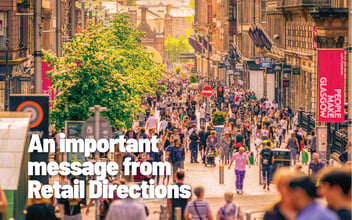Valuable lessons for retailers from the ghosts of past, present, and future!
When Ebenezer Scrooge was stuck in his ways, he had the benefit of timely visits from the ghosts of the past, present and future to teach him how to change his ways. As we move into 2022, we come bearing a candid look at the past, present, and future for retailers too. Sitting comfortably?
Perhaps you might not be the archetypal Ebenezer Scrooge of Charles Dickens' A Christmas Carol, but if the past couple of years are anything to go by, you will need to learn from the past, be prepared for the ever-changing present, and be bold and brave in the future to try new strategies.
Although in-trend products have gone from three-piece suits to athleisure wear, consumer demand for a pain-free, convenient, and swift shopping experience is as high as it ever has been.
Yes - the effects of the pandemic continue to disrupt high street stores, but only now are online retailers getting to grips with the ‘hidden costs’ of e-commerce with returns, reverse logistics, and customer service all becoming key sticking points.
So as we head into Christmas 2021, let’s take a leaf out of Charles Dickens’ classic novella and see what lessons can be drawn from the past, present and how UK retailers need to prepare their business strategies for the year ahead?
The Past: How Covid-19 affected retailers
The effects of Covid-19 have split retailers into two categories - those that are surviving and thriving, and those that aren’t.
Plenty of retailers blamed the effects of Covid on them going out of business, but Covid has only really uncovered the cracks that were already there, speeding up the process for those that didn’t move online and implement an omni-channel, connected retail strategy.
Many retailers underestimated what was needed to cope with the sudden shift to online. As well as a drastic change in buyer behaviour, some retailers have been slow to recognise that shoppers wanted almost completely different products and services to the ones they purchased pre-pandemic.
As social and work behaviours have changed, there isn’t as much of a need to go out and buy a new outfit. Those retailers that quickly realised this switched their focus to items that are in more demand. For example, apparel stores have started expanding their product ranges to include homewear, baking goods, and other types of in-home items that have become more popular during this time - an opportunity which they maybe would have never even considered before.
It was these retailers, bold and brave enough to make a change, that have thrived over the past 12 months. They were the ones that did things that even they didn't think were possible before, able to scale online operations quick enough and fulfil the right type of products.
The Present: The battle of online vs brick-and-mortar
For brick-and-mortar retailers that scaled online channels during the pandemic, the difference has been getting a grip on this change in strategy. Whereas online before was a relatively small part of their business, suddenly it’s taking up significantly more of their time, budget, and resources.
Many retailers have had to adapt and change their entire processes, supply chains, and back-end systems just to cater to online consumers. The hidden costs of e-commerce, such as online customer service, returns, and reverse logistics have come as a bit of a shock to some.
The big difference for online retailers has been in how they’ve dealt with the delivery experience. Pureplay online retailers such as Amazon have conditioned us as consumers to expect next day delivery as a given when we order anything online, and whilst retailers such as Argos have long embraced the idea of click-and-collect they now also support same day deliveries.
In New Zealand for example, Uber is taking that one step further, running a pilot that allows consumers who live within 20km of any retail store to order items online and they will have it with them within the hour.
In response to Covid, retailers may have built a rod for their own back in some way, creating a culture of instant gratification. Retailers have raised the bar on expedited deliveries, and we're now seeing customers feeling let down because the item they were promised next-day didn’t show up within 24 hours.
UK businesses are especially struggling to meet delivery demand because of the issues with the supply chain, driver shortages, and even Brexit border delays. The online experience is starting to suffer as a result, with consumers potentially losing faith that online purchases can be delivered on time, choosing to go back into shops instead.
Delivery has therefore become one of the biggest reasons in driving people to make purchases, but all of this could be good news for high street stores as it will only drive footfall up as people change their preferences to go back in-store to get the goods and shopping experiences they crave.
The Future: What can retailers expect for 2022?
In short, more uncertainty. The delivery experience and supply chain issues we’ve seen recently are likely going to get worse before they get better. At the same time, costs are also going to rise with increases in inflation, and all the debt that retailers may have run up has got to be paid back somehow.
But arguably the biggest issue retailers will face in 2022 is their own staff. Retailers need to focus on their employees and hiring strategy just as much as they focus on their customers. The retail industry is typically seen as one which people fall into if they can't get a job elsewhere. Retailers have the opportunity to change the perception of the retail industry to be a desirable career choice.
By making the retail industry a more attractive place to work, the customer experience will become a source of differentiation for retailers. So retailers will either need to invest more, or run a lot leaner through efficiencies than they are right now, while focusing on creating a more positive culture for their employees.
If the issue of staff shortages can’t be solved, retailers will have to look into increasing their tech stack to streamline their processes. For example, investing in more self-checkout services or increasing the connected retail experience would allow consumers to order, collect, and receive their goods anywhere or at any time they choose.
Fulfilment will also become an even bigger priority in 2022, especially if supply chain issues continue to disrupt. Retailers will have to find the right balance between streamlining current resources and making sure they have the right people able to deal with day-to-day tasks.
“The Spirits of all Three shall strive within me. I will not shut out the lessons that they teach.”
- Ebenezer Scrooge, ‘A Christmas Carol’.
Regardless of the past, present and future challenges facing the retail industry, continually educating consumers on the delivery of new shopping experiences (such as in-store mobile shopping) will help retailers differentiate themselves.
Retailers are improving fulfilment issues by leveraging their brick-and-mortar stores to operate as distribution centres - offering services such as same day click-and-collect and ship-from-store.
Overall, the year ahead in 2022 will be about building resiliency into a retail strategy. We know that it’s impossible to be ready for anything, but by connecting the offline and online experience and making services more flexible, retailers can reduce any disruption that comes their way while remaining customer focused.






